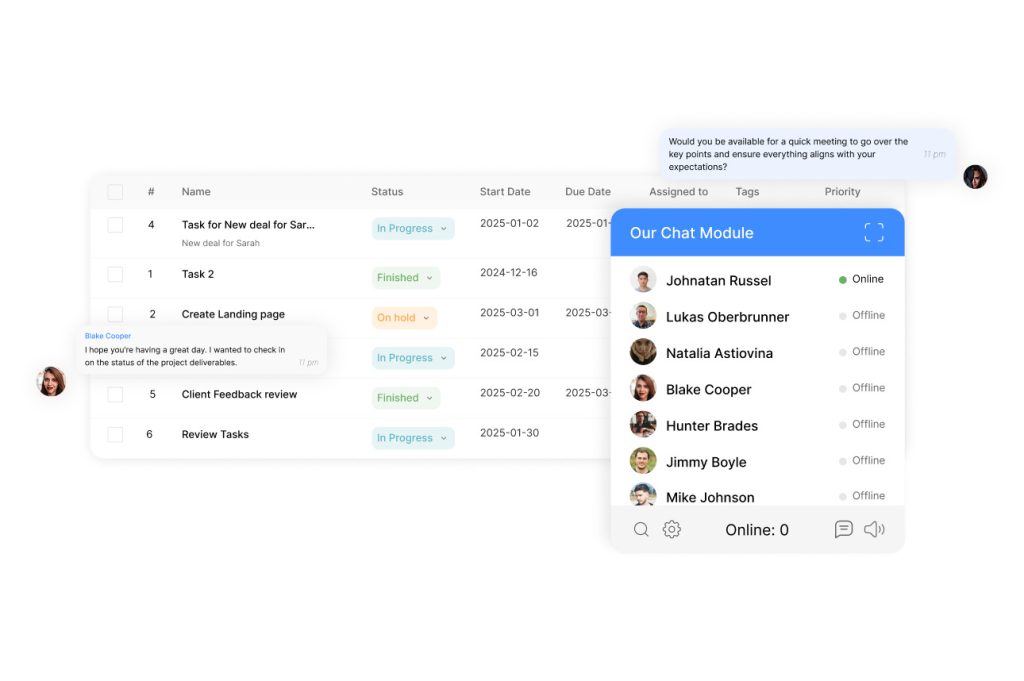Private Chat Platforms: A Roundup of Top Business Tools

Modern organizations face increasing risks to sensitive data. Choosing the right team communication platform isn’t just about convenience—it’s a strategic decision that directly impacts security, compliance, and client trust. As cyberthreats evolve, businesses need tools that combine robust protection with seamless workflows.
Today’s market offers a range of private messaging apps tailored for professional use. These tools vary widely in encryption protocols, user permissions, integration capabilities, and metadata handling. Decision-makers must prioritize features like end-to-end encryption, granular access controls, and scalability to meet their company’s operational and regulatory demands.
This article evaluates leading platforms through two core lenses: technical safeguards and real-world business utility. It explores how these systems support compliance with frameworks like HIPAA and GDPR, all while maintaining high levels of productivity. The goal: help businesses align their communication strategy with long-term security and growth objectives.
By understanding what each solution offers, organizations can prevent data breaches without sacrificing speed or user experience. The right platform strengthens internal communication and protects confidential exchanges with clients, partners, and stakeholders.
Key Takeaways
- Data protection standards directly impact compliance and client trust
- End-to-end encryption remains non-negotiable for sensitive exchanges
- Scalable solutions adapt to growing teams and complex workflows
- Integration with existing software reduces operational friction
- Audit trails and access controls simplify regulatory compliance
Overview of Leading Private Chat Solutions
Business communication tools now demand equal parts functionality and protection. Five platforms stand out for balancing these priorities while addressing distinct organizational needs.
Secure Messaging Leaders
Signal leads with nonprofit transparency and military-grade encryption, making it ideal for sensitive exchanges. WhatsApp’s 2 billion-strong user network offers convenience for teams needing broad client compatibility. Telegram merges messaging with social engagement through channels supporting 200,000+ members and automated workflows.
Emerging apps push boundaries: Session enables anonymous sign-ups through blockchain technology, while Briar’s peer-to-peer design bypasses central servers entirely. These solutions prove secure collaboration doesn’t require sacrificing modern features.
Shifting Market Demands
Recent surveys show 68% of US businesses prioritize encryption in communication tools. Users expect platforms to integrate with CRM systems and project management software without compromising data integrity. Interface simplicity now ranks equal to advanced security protocols in procurement decisions.
Platforms adapting fastest combine zero-knowledge architectures with intuitive dashboards. This dual focus helps teams maintain compliance while streamlining cross-department coordination. As remote work expands, scalable solutions supporting file sharing and timed message deletion gain traction.
The Importance of Private Chat for Businesses

Undeniably, every corporate conversation holds value in today’s data-driven economy. Consequently, cybercriminals target messaging systems to harvest details for identity theft, AI-generated scams, and extortion schemes. For example, a single compromised email chain can expose client financial records or reveal strategic negotiations.
Metadata analysis poses equal risks. Competitors dissect communication patterns to map decision-makers, supply chains, and partnership timelines. Insurance firms use this data to adjust premiums based on inferred risk profiles—a practice creating systemic disadvantages for smaller companies.
The fallout extends beyond immediate breaches:
- Regulatory penalties under HIPAA or GDPR for mishandling client information
- Revenue losses from stolen intellectual property
- Erosion of customer trust lasting years post-incident
Financial institutions face heightened threats. Fraudsters reconstruct social graphs from communication logs to manipulate stock trades or loan approvals. Secure messaging platforms combat these tactics through encrypted channels and access controls that meet compliance mandates.
Forward-thinking companies leverage protected systems to:
- Shield pricing strategies from market analysis
- Prevent third-party surveillance of merger talks
- Demonstrate privacy commitments to partners
As AI tools refine data extraction methods, robust messaging safeguards become non-optional. They transform communication from a vulnerability into a competitive asset.
Key Features of Top Private Messaging Apps

Modern business tools require layered defenses against evolving digital threats. Leading platforms now combine military-grade protection with intelligent workflow enhancements, creating secure environments for sensitive exchanges.
End-to-End Encryption and Security Protocols
Two-layer encryption systems like those in SimpleX set new standards for data security. These protocols wrap messages in multiple cryptographic layers, preventing third-party access even if one layer gets compromised. Content padding further disguises transmission patterns, making metadata analysis nearly impossible.
Advanced platforms extend this protection across all communication types. Voice calls and file transfers receive the same rigorous safeguards as text exchanges. This comprehensive approach ensures sensitive contracts or financial details remain confidential during transit and storage.
Unique Functionalities Enhancing Privacy
Temporal controls help businesses manage information lifecycle risks. Disappearing messages auto-delete after set intervals, reducing exposure from forgotten threads. Combined with incognito modes that avoid account linkages, teams can discuss mergers or patents without leaving digital footprints.
Importantly, portable encrypted storage solutions address another critical need. At the same time, organizations maintain full message histories while enabling secure device transitions—a vital feature for remote teams upgrading hardware. Ultimately, these features demonstrate how top apps balance ironclad security with practical business requirements.
Understanding Metadata Privacy and User Anonymity
Digital footprints often hide in plain sight. Traditional messaging systems leave trails of user identifiers that expose organizational networks. Protecting communication patterns matters as much as securing message content for modern businesses.
How Eliminating User IDs Enhances Privacy
Most platforms assign permanent identifiers like phone numbers or emails. These create vulnerabilities: competitors map team structures via user connections, while hackers exploit centralized data stores. SimpleX Chat removes identifiers entirely, using disposable message queues instead.
Specifically, this architecture prevents reconstructing social graphs. Consequently, each conversation generates unique anonymous links, erasing persistent ties between users. Furthermore, businesses gain protection against industrial espionage and regulatory scrutiny over historical information.
The Role of Temporary Pairwise Identifiers
Ephemeral tokens replace static IDs in advanced systems. These self-destruct after sessions, leaving no analyzable patterns. Key benefits include:
- No central user database for attackers to target
- Randomized routing paths for messaging traffic
- Automatic deletion of connection metadata
| Aspect | Traditional Platforms | SimpleX Approach |
|---|---|---|
| User Identification | Permanent IDs | Temporary Tokens |
| Data Exposure | Centralized Metadata | Zero Stored Logs |
| Compliance Risk | High | Minimal |
By obscuring communication timing and frequency, companies prevent inference of sensitive activities. This shields merger plans, R&D cycles, and client negotiations from external analysis.
Server Architecture and Messaging Queues Explained

To begin with, robust server infrastructure forms the backbone of secure business communication systems. Moreover, leading platforms now adopt distributed designs that eliminate single points of failure while ensuring reliable message delivery. In contrast, unlike centralized models, these architectures prevent any single entity from controlling entire conversation flows.
SimpleX’s approach uses unidirectional queues across separate servers for sending and receiving messages. Each conversation typically routes through two independent servers, with users controlling inbound traffic and contacts managing outbound channels. This separation ensures no single server accesses complete data streams.
| Feature | Centralized Systems | Distributed Architecture |
|---|---|---|
| Message Routing | Single Server | Multiple Nodes |
| Failure Risk | High | Minimal |
| Latency | Variable | Geographically Optimized |
Organizations gain operational flexibility through server selection options. Teams can deploy private servers while maintaining compatibility with external networks. This hybrid model supports secure communication with partners using different infrastructures.
Key advantages include:
- 24/7 message delivery via asynchronous queues
- Bandwidth reduction through localized routing
- Custom bot development using open SDKs
Distributed systems automatically reroute messages during outages, maintaining business continuity. Combined with enterprise-grade encryption, this architecture scales securely as operational needs evolve.
Comparative Analysis: Private Chat Versus Other Protocols
Business communication architectures directly influence operational security and efficiency. Traditional models like centralized systems or peer-to-peer networks present unique trade-offs between control and vulnerability. Hybrid approaches now redefine expectations for enterprise-grade messaging solutions.
Centralized vs Distributed Architectures
Centralized platforms store all user data on single servers—a design creating systemic risks. If breached, attackers gain access to entire communication histories and organizational charts. This model also enables third-party surveillance through mandatory metadata collection.
Peer-to-peer (P2P) networks eliminate central servers but introduce new challenges. Routing messages through multiple devices increases latency and exposes conversations to Sybil attacks. Studies show 42% of P2P systems experience message loss during high-traffic periods.
| Network Type | Reliability | Attack Resistance |
|---|---|---|
| Centralized | High | Low |
| P2P | Variable | Moderate |
| Hybrid | Consistent | High |
Federated Limitations and Modern Alternatives
Federated apps interconnect servers but retain persistent user profiles. This allows correlation of communication patterns across organizations. Hybrid systems like SimpleX avoid these pitfalls through temporary identifiers and segregated message queues.
Key advantages of advanced architectures include:
- No centralized metadata repositories
- Automatic traffic rerouting during outages
- Compliance with strict privacy regulations
By combining server reliability with decentralized security, modern platforms enable businesses to maintain operational continuity without sacrificing protection. This balanced approach meets evolving demands for confidential yet efficient messaging.
User Experiences and Real-World Applications
Effective communication platforms prove their value through practical implementation. Organizations across industries now leverage secure tools to address specific operational challenges while maintaining productivity. Below are examples demonstrating how different systems meet unique business needs.
Industry-Specific Implementations
Signal serves healthcare providers handling patient data, combining HIPAA-compliant encryption with intuitive interfaces. Its nonprofit model reassures users prioritizing audit-ready security. Legal firms adopt it for client discussions requiring airtight confidentiality.
WhatsApp’s 2 billion-user network helps sales teams engage global clients effortlessly. Retailers use its broadcast lists for time-sensitive promotions, while consultants share project updates via encrypted documents. Network effects simplify onboarding external partners.
Telegram’s 200,000-member channels let brands build communities through content sharing and polls. Media companies distribute breaking news, while educators host Q&A sessions. Automated bots streamline order tracking and customer support workflows.
For high-stakes scenarios, Session enables anonymous tip lines and whistleblower reporting. Financial institutions use it for merger talks, avoiding digital footprints. Its blockchain architecture appeals to users needing untraceable negotiations.
Briar’s peer-to-peer design supports journalists in censored regions. Activists coordinate securely without internet access, while NGOs share field reports offline. These apps prove secure messaging adapts to diverse operational demands.
- Healthcare: Signal ensures HIPAA compliance in patient communication
- Retail: WhatsApp bridges client outreach and internal coordination
- Media: Telegram transforms audience engagement through scalable channels
Adoption success hinges on balancing security with usability. Platforms aligning encryption standards with workflow needs see 73% higher employee retention rates. As threats evolve, real-world applications guide smarter tool selection.
Integrating Private Chat in Business Collaboration Tools

Seamless integration of secure messaging platforms into enterprise ecosystems boosts productivity while maintaining compliance. Modern apps like Signal and Telegram now offer group capacities ranging from 40-person video calls to 200,000-member announcement channels. These tools bridge the gap between protected communication and collaborative workflows.
File-sharing features enable encrypted document exchanges without switching platforms. Teams edit contracts or review designs within encrypted threads, maintaining version control and audit trails. This eliminates risky email attachments while preserving workflow continuity.
Voice and video conferencing integration reduces reliance on third-party services. Secure meetings occur directly within messaging interfaces, lowering vulnerability points. Administrators manage access levels through granular permissions, ensuring sensitive discussions stay compartmentalized.
APIs and SDKs allow custom connections with CRM systems or project management software. Developers build automated alerts for sales pipelines or inventory updates directly into communication streams. This flexibility supports specialized workflows without compromising security protocols.
Successful migration strategies prioritize phased rollouts and staff training. Companies transfer historical data using encrypted backups while maintaining legacy systems during transitions. Clear adoption timelines minimize disruptions to critical group operations.
Technical Deep Dive: Encryption, Servers, and Protocols
Advanced security architectures separate effective communication tools from vulnerabilities. Leading platforms combine cutting-edge cryptography with resilient infrastructure to protect sensitive exchanges. These systems ensure data remains shielded during transmission and storage while meeting enterprise scalability demands.
Exploring End-to-End Encryption and Forward Secrecy
SimpleX employs a double ratchet algorithm that updates encryption keys after every exchange. This approach provides forward secrecy, rendering past messages unreadable if current keys get compromised. Temporary session keys add another layer, ensuring intercepted data stays protected even during network breaches.
How Data and Messages Are Securely Transmitted
Each message includes a cryptographic hash of its predecessor, creating an unbroken integrity chain. Third-party security firm Trail of Bits validated these protocols in 2022, confirming resistance to tampering and interception attempts. Systems automatically reroute messages through multiple nodes without storing metadata.
Key advantages for businesses:
- Self-healing encryption adapts to emerging threats
- Zero stored logs simplify regulatory compliance
- Asynchronous delivery maintains workflow continuity

